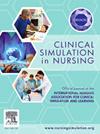Understanding interprofessional co-debriefing practices within large scale ward-based simulation
IF 2.5
3区 医学
Q1 NURSING
引用次数: 0
Abstract
Background
Despite growing use of interprofessional simulation in healthcare education, there is a lack of published frameworks to guide structured, co-facilitated debriefing between professions. This study explored how nursing and allied health facilitators engage in interprofessional co-debriefing within a large-scale, ward-based simulation program involving over 2000 health students.
Methods
Twelve interprofessional co-debriefings were observed and assessed using the debriefing assessment for simulation in healthcare (DASH) tool, with both rater (observer) and instructor (debriefer) versions. Mean debriefing assessment for simulation in healthcare (DASH) scores were compared across five core elements. Qualitative data from instructor short-answer responses and observer field notes were also analysed.
Results
Raters consistently scored debriefings higher than instructors, except where debriefers lacked formal training. Three key themes emerged: the interplay between co-facilitation and debriefing structure, uncertainty impedes curiosity and, ``phew, my students are chatty.''
Conclusion
This study is among the first to directly examine real-world interprofessional co-debriefing practices. It highlights the critical need for structured guidance in co-debriefing, identifies challenges unique to interprofessional facilitation, and provides practical insights to support the development of future interprofessional debriefing frameworks.
理解大型病房模拟中跨专业的联合汇报实践
尽管在医疗保健教育中越来越多地使用跨专业模拟,但缺乏公开的框架来指导专业之间结构化的、共同促进的汇报。本研究探讨了在一个涉及2000多名卫生专业学生的大型病房模拟项目中,护理人员和联合卫生促进者如何参与跨专业共同汇报。方法采用模拟医疗保健述职评估(DASH)工具,对12例跨专业联合述职进行观察和评估,包括评定者(观察员)和指导者(述职者)两种版本。在五个核心要素之间比较了模拟医疗保健(DASH)得分的平均汇报评估。还分析了讲师简短回答和观察员实地记录的定性数据。结果除了汇报者缺乏正式培训外,评分者对汇报的评分始终高于指导员。三个关键主题出现了:共同促进和汇报结构之间的相互作用,不确定性阻碍了好奇心,以及“哇,我的学生很健谈。”这项研究是第一个直接研究现实世界跨专业共同汇报实践的研究。它强调了在共同汇报中对结构化指导的迫切需要,确定了跨专业促进所特有的挑战,并提供了实用的见解,以支持未来跨专业汇报框架的发展。
本文章由计算机程序翻译,如有差异,请以英文原文为准。
求助全文
约1分钟内获得全文
求助全文
来源期刊

Clinical Simulation in Nursing
NURSING-
CiteScore
5.50
自引率
15.40%
发文量
107
期刊介绍:
Clinical Simulation in Nursing is an international, peer reviewed journal published online monthly. Clinical Simulation in Nursing is the official journal of the International Nursing Association for Clinical Simulation & Learning (INACSL) and reflects its mission to advance the science of healthcare simulation.
We will review and accept articles from other health provider disciplines, if they are determined to be of interest to our readership. The journal accepts manuscripts meeting one or more of the following criteria:
Research articles and literature reviews (e.g. systematic, scoping, umbrella, integrative, etc.) about simulation
Innovative teaching/learning strategies using simulation
Articles updating guidelines, regulations, and legislative policies that impact simulation
Leadership for simulation
Simulation operations
Clinical and academic uses of simulation.
 求助内容:
求助内容: 应助结果提醒方式:
应助结果提醒方式:


